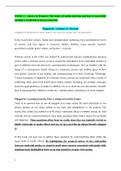Samenvatting
Summary Topic Always Connected: Key Insights In Youth, Media And Technology (Lecture & Literature Week 7)
- Instelling
- Universiteit Van Amsterdam (UvA)
Providing an in-depth and complete section of notes from the course of Topic Always Connected: Key Insights In Youth, Media And Technology. The present document includes a summary of the reading material and lecture of week 7 of the course. Notes include: - Summary of the literature assigned fo...
[Meer zien]




